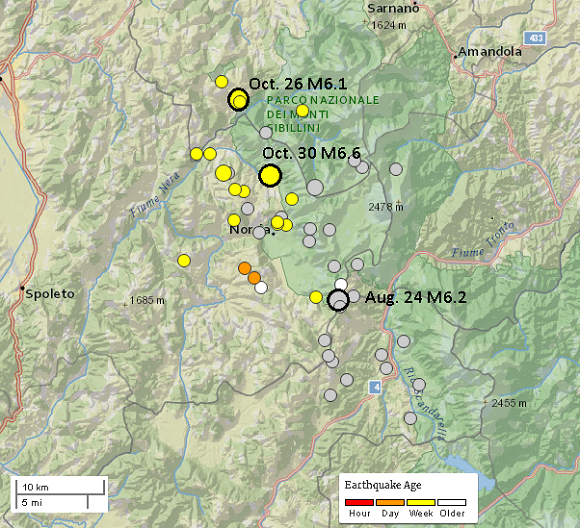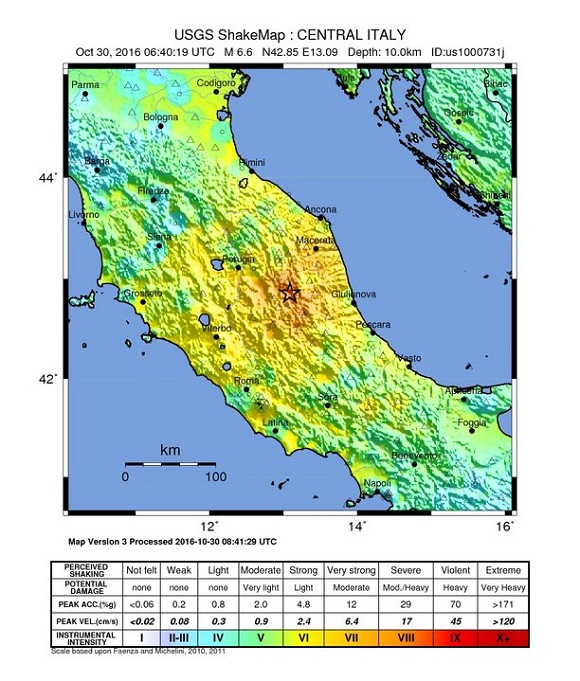Norcia Earthquake Central Italy
Status: Closed
| Type of posting | Posting date(EST): | Summary | Downloads |
|---|---|---|---|
| First Posting | 10/31/2016 1:00:00 PM |
|
First Posting | Summary
Posting Date: October 31, 2016, 1:00:00 PM
The largest in a complex sequence of related earthquakes struck central Italy at 7:40 a.m. CEST (2:40 a.m. ET) on October 30, severely damaging the town of Norcia 90 kilometers (56 miles) north of Rome. Sunday’s temblor was the most powerful to hit the country in more than three decades. Since the M6.2 earthquake that severely damaged the town of Amatrice on August 24, the USGS has reported 44 events of M4.0 and larger in the region. Fortunately there are no reports of casualties following this most recent event, many residents having left the region because of the earlier earthquakes.
Seismology
Central Italy is a tectonically and geologically complex region. Yesterday’s M6.6 quake occurred approximately 10 km southeast of the October 26 M6.1 quake and is related to the previous seismicity. According to the USGS, the larger size of the October 30 earthquake implies it has ruptured an independent fault patch that had not slipped as part of the preceding earthquakes. Like preceding events, this earthquake was the result of crustal normal faulting with a shallow focal depth of 10.0 kilometers. All recent intraplate earthquakes follow a NW-SE trend in the central Apennine Mountains.
As of 3:30 UTC on October 31, the M6.6 earthquake had been followed by seven M4.0+ aftershocks, but there have been more than 200 smaller aftershocks occurring every 20 minutes or so. Aftershocks are expected to continue for weeks or possibly for months, and there is a low probability of similar sized or larger events occurring.
Reported Damage
The largest instrumentally recorded rupture in the region was a devastating 1915 M6.7 earthquake, which resulted in approximately 32,000 deaths. A small number of injuries have been reported as a result of the latest quake, but no deaths. Italy's Civil Protection Department reports at least 4,000 people put up in hotel rooms on the Adriatic coast and a further 10,000 in temporary shelters in the regions of Umbria and Marche. Others slept in their cars. More than 1,100 people are still in temporary accommodations following the August 24 quake.
The timing of a sequence of earthquakes like this can have a serious impact on the vulnerability of buildings, compromising their seismic resistance and leading to accumulated damage or even to collapse. The October 30 earthquake has both added to the damage caused by earlier events in the sequence and added to the destruction. It damaged historic buildings as far away as Rome and led to the closure of schools there, but most damage is reported in the medieval walled town of Norcia, close to the epicenter. The Basilica of San Benedetto, which marks the traditional birthplace of St. Benedict, founder of the Benedictine monastic order, and the Cathedral of St. Mary Argentea, known for its 15th century frescoes, have been virtually destroyed. Other casualties in this area rich in cultural heritage include Roman walls, a medieval tower, and other landmarks. The towns of Castelsantangelo and Preci, largely abandoned after last week's quakes, also suffered considerable destruction. Many homes have been damaged, and some villages in the area are still cut off.
Exposure at Risk
The majority of buildings in Italy are constructed with unreinforced masonry, reinforced masonry, or reinforced concrete construction. Because most structures were built before the introduction of comprehensive seismic building codes and modern construction technology, the risk of collapse during an earthquake for those erected prior to 1980 is very high.
In 1996 provisions were introduced to limit excessive building flexibility, which can cause damage to the nonstructural elements of a building during low-to-medium intensity earthquakes. The pre-1996 seismic codes usually have deficiencies that result in a high risk of collapse during powerful earthquakes and high risk of nonstructural damage during weaker ones. The seismic codes in Italy did not change significantly until 2003, when an update put most of the areas affected by these earthquakes in the high seismic zone, where strict design is required; thus, buildings built after 2004 in these areas are expected to be less vulnerable.
Industry Impacts
Italy’s nonlife insurance market is the eighth-largest in the world and the fifth-largest in Europe; its property insurance market is the second-largest nonlife market in the country after automobile. However, earthquake coverage is often not included in standard homeowners’ policies and is typically issued as an extension of fire policies. For industrial and commercial structures, earthquake coverage may be offered for an additional premium, which varied by region. The government budget includes provisions for post-disaster insurance payouts instead of a state pool or catastrophe fund into which companies can contribute.
The AIR earthquake team will continue to monitor the situation and provide additional information as warranted.